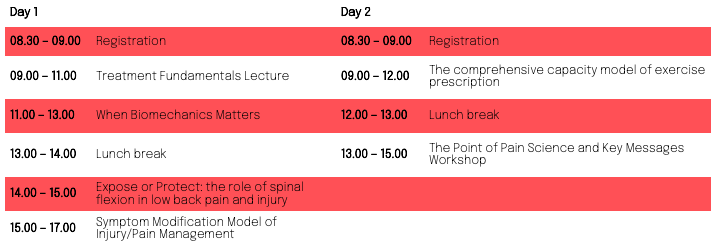Reconciling biomechanics with pain science
This course provides a framework to utilize an alternative biomechanical approach that blends neuroscience pain education.
Description
Taal scholing: Engels - Geaccrediteerd voor het beroepsgerelateerd deel en het algemeen, sport & manueel register - Keurmerk: 14 punten - KRF: 14 punten - ProQKine: geen accreditatie aangevraagd. Mocht je hier wel interesse in hebben, neem dan even contact met ons op!
Wij doen ons uiterste best om onze scholingen in deze tijd door te laten gaan volgens nationale en internationale richtlijnen rondom COVID-19. Mocht er iets veranderen voor deze scholing, dan brengen we je zo snel mogelijk op de hoogte.
Significant research in the pain neurosciences and biomechanics field often appears to undermine the reasoning and justifications for many of the traditional therapeutic approaches and techniques of the many rehabilitation professions. By addressing both the weaknesses and strengths of the biomechanical approach we can see that treatment can be much simpler, congruent with the cognitive, neuroscience approach and best evidenced based practice.
This course provides a framework to utilize an alternative biomechanical approach that blends neuroscience pain education. This course teaches the therapist how to teach patients about pain science in a treatment framework that still utilizes specific/corrective exercise and manual therapy. Therapists are taught a model of treatment that simplifies the assessment process and the treatment.
Learning style
This course is a mix of a discussion based lecture, case studies and practical components. The practical components are used with the case studies to “feel” the interventions. However, there no “specific” techniques. Rather, the point is to show that the framework helps the therapist use their own techniques but in a different way. Further, we can then share “techniques” from all participants in the class. Exercises are demonstrated and time is given to practice these exercises. When exploring how Key Messages relate to pain and changing behaviour the practical component helps the therapist use their own experiences and “stories” to fit with the Key Messages of pain and behaviour change.
Objectives
-
Provide assessment techniques to aid in diagnosis and management common musculoskeletal complaints
-
Demonstrate how biomechanical treatments and explanations can address the multidimensional nature of pain
-
Demonstrate how cognitive restructuring and goal setting of meaningful activities can be used alongside mechanical treatments to address the multidimensional nature of pain
-
Provide and teach exercise prescription that is informed by biomechanics and therapeutic neuroscience
-
Explain the “pain science” behind common clinical problems and learn methods of applying therapeutic neuroscience education
-
Identify and use their current movement based skills within a graded exposure and graded activity paradigm
The course outline can be found here
Timetable

Spreker
Specialist
 Lees hier alles over Greg Lehman!
Lees hier alles over Greg Lehman!